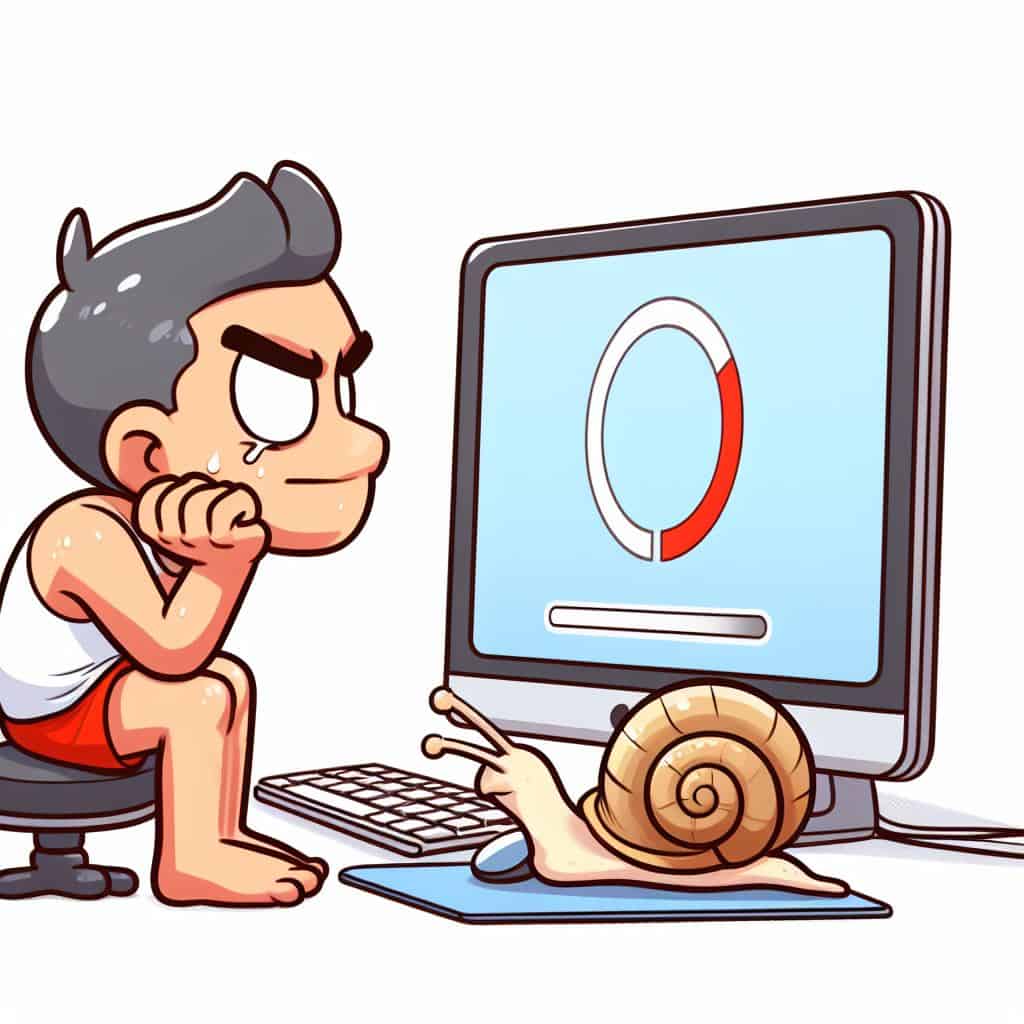Are you tired of the never-ending buffering wheel and the frustration of snail-paced internet? You’re not alone. We’ve all been there, hitting our breaking point when slow internet disrupts our online activities. But fear not, as this guide is here to the rescue!
In a world where fast and reliable internet is essential, we’ll show you how to bid farewell to the agony of sluggish connections and usher in an era of uninterrupted streaming, seamless gaming, and smooth work productivity. Buckle up as we embark on a journey to fix your slow internet and restore your online sanity!

- Identifying the Issue: Understanding what might be causing your slow internet speeds.
- Checking Your Connection: Examining your hardware and ensuring it's working optimally.
- Updating Your Router Firmware: Exploring the benefits of keeping your router's software up to date.
- Optimizing Wi-Fi Settings: Adjusting your Wi-Fi settings for better performance.
- Choosing the Right Wi-Fi Channel: Discovering how selecting the appropriate channel can improve your internet speed.
- Clearing Cache and Cookies: Learning how clearing temporary files can enhance your browsing experience.
- Managing Background Processes: Identifying and closing unnecessary programs that may be slowing down your internet.
- Running a Speed Test: Using online tools to measure your internet speed accurately.
- Contacting Your Internet Service Provider: Understanding when it's time to reach out for professional assistance.
- Exploring Alternative Internet Options: Research other internet providers or technologies that may offer faster speeds in your area.
- FAQ
Identifying the Issue: Understanding what might be causing your slow internet speeds.
Having slow internet speeds can be frustrating, especially when you rely on a fast and stable connection for various online activities like streaming, online gaming, or video conferencing.
To improve your internet speed, it’s important to first troubleshoot and identify the underlying issue.
One possible cause of slow internet speeds could be connectivity issues within your network. This can be the result of factors such as limited bandwidth, high latency, or a weak Wi-Fi signal.
To diagnose and resolve these issues, it’s crucial to check the configuration settings of your router, modem, and internet service provider (ISP).
Updating the firmware of your router will enhance its performance and compatibility with the latest technologies.
Additionally, optimizing your Wi-Fi settings, such as adjusting the Wi-Fi channels to avoid congestion and interference, can speed up your connection.
Furthermore, managing background processes on your devices, which may be using up valuable resources and causing slowdowns, can significantly boost your internet speed.
Checking Your Connection: Examining your hardware and ensuring it’s working optimally.
When it comes to troubleshooting slow internet speeds, one of the first steps you should take is checking your connection and examining your hardware.
Start by inspecting all the cables and connections to ensure they are properly plugged in and secure.
Sometimes, a loose cable or connection can result in slower speeds. Additionally, take a look at your modem and router to ensure they are functioning correctly.
Check for any signs of damage or wear, and if necessary, consider replacing outdated equipment with newer models that offer faster speeds and improved performance.
Another aspect to consider when checking your connection is the location of your modem and router. Ideally, these devices should be placed in a central area of your home to maximize signal strength and coverage.
Avoid positioning them near other electronics or objects that may cause interference, such as microwaves or metal objects.
Additionally, make sure that your modem and router are elevated off the ground to allow for better airflow and reduce the risk of overheating.
Taking these simple steps can help ensure that your hardware is working optimally and can potentially improve your internet speed.
Updating Your Router Firmware: Exploring the benefits of keeping your router’s software up to date.
One of the crucial steps in optimizing your internet speed is ensuring that your router’s firmware is up to date.
Firmware is the software that runs on your router and controls its functionality. By regularly updating the firmware, you can benefit from improved performance, enhanced security, and new features.
Updating your router’s firmware is relatively simple and can be done either manually or automatically, depending on the router model. Manufacturers often release firmware updates to fix bugs, patch vulnerabilities, and optimize the router’s performance.
These updates can address issues that may be causing slow internet speeds, ensuring that your connection remains stable and efficient. Additionally, updating the firmware can enhance security by patching potential vulnerabilities, protecting you from cyber threats. If you haven’t updated your router’s firmware recently, it is worth checking for any available updates to ensure you are getting the best performance out of your device.
Optimizing Wi-Fi Settings: Adjusting your Wi-Fi settings for better performance.
 When it comes to optimizing your Wi-Fi settings for better performance, there are a few key adjustments you can make to ensure you’re getting the most out of your connection.
When it comes to optimizing your Wi-Fi settings for better performance, there are a few key adjustments you can make to ensure you’re getting the most out of your connection.
First, take a look at your wireless network name, also known as the SSID.
It’s important to choose a unique and easily identifiable name for your network, as this can help avoid interference from neighboring Wi-Fi networks.
Additionally, be sure to password-protect your network to prevent unauthorized access.
Next, consider the channel your Wi-Fi network is operating on. By default, most routers will automatically select a channel for you, but it’s worth checking if switching to a less crowded channel can improve your internet speed.
You can do this by accessing your router’s settings through a web browser and navigating to the Wi-Fi section. Look for an option to manually select a channel and experiment with different ones to see if you notice any improvement.
Overall, taking the time to optimize your Wi-Fi settings can go a long way in improving your internet speed and overall user experience.
By choosing a unique network name, securing your network with a password, and selecting an ideal Wi-Fi channel, you can ensure you get the most out of your wireless connection.
So, try these simple adjustments and enjoy a faster and more reliable internet connection in your home or office.
Choosing the Right Wi-Fi Channel: Discovering how selecting the appropriate channel can improve your internet speed.
When it comes to optimizing your Wi-Fi speed, choosing the right Wi-Fi channel can make a world of difference.
Most routers automatically select a channel for you, but it’s important to know that this default channel may not always be the best option.
Wi-Fi channels operate on different frequencies, and if you live in an area with many neighboring networks, interference can significantly affect your internet speed.
To ensure the best connection, you can manually select the optimal Wi-Fi channel for your network.
Start by accessing your router’s settings through a web browser. Look for the “Wireless” or “Wi-Fi” settings and locate the channel selection. It’s recommended to choose a channel that is less crowded and has less interference from other nearby networks.
This can be determined by using a Wi-Fi analyzer tool, which can help you identify the channels with the least congestion. By selecting the right Wi-Fi channel, you can significantly enhance your internet speed and enjoy a seamless online experience.
Clearing Cache and Cookies: Learning how clearing temporary files can enhance your browsing experience.
When it comes to improving our browsing experience, one effective method is clearing cache and cookies.
Cache and cookies are temporary files stored on our computers, and over time, they can accumulate and slow down our internet speed. By regularly clearing these files, we can optimize our browsing speed and enjoy a smoother online experience.
When we visit websites, our browsers store certain elements from those sites in the cache. This allows the browser to quickly access the information and load the page faster when we visit the site again.
However, over time, the cache can become overloaded with unnecessary data, causing our browsers to slow down. Clearing the cache helps to remove this excess data, enabling the browser to operate at its optimal speed.
Additionally, cookies are small text files that websites store on our computers to remember our preferences and improve our browsing experience.
However, if we accumulate too many cookies, they can also contribute to a slow internet speed.
Hence, regularly clearing cache and cookies is a simple yet effective way to enhance our browsing experience and maintain a fast internet connection.
Managing Background Processes: Identifying and closing unnecessary programs that may be slowing down your internet.
When it comes to managing background processes, it’s important to identify and close unnecessary programs that may be slowing down your internet.
Trust me, I’ve been there and know how frustrating it can be to have a sluggish connection. So, let’s dive right in and tackle this issue head-on.
First things first, take a moment to assess which programs are running in the background of your computing device. Look for any applications that you aren’t actively using but are still consuming valuable internet resources.
This could include things like file syncing software, automatic software updates, or even streaming services running in the background.
By closing these unnecessary programs, you can free up precious Internet bandwidth and give your Internet connection a much-needed boost. ????????
 Running a Speed Test: Using online tools to measure your internet speed accurately.
Running a Speed Test: Using online tools to measure your internet speed accurately.
Have you ever wondered if your internet service provider is delivering the internet speed you’re paying for? Running a speed test is a quick and easy way to find out.
There are numerous online tools available that allow you to measure your internet speed accurately.
Simply search for “internet speed test” on your favorite search engine, and you’ll find a variety of options to choose from.
To run a speed test, all you need to do is click on the “Start” or “Begin Test” button on the website you’ve selected. The test will then analyze your download and upload speeds, as well as the ping rate.
The download speed refers to how quickly you can access information from the internet, while the upload speed indicates how fast you can send data.
The ping rate, on the other hand, measures the latency or delay between your computer and the server.
By running a speed test, you can get a clear picture of your internet speed and better understand the performance you’re getting from your ISP.
Contacting Your Internet Service Provider: Understanding when it’s time to reach out for professional assistance.
When it comes to internet issues, sometimes it’s best to leave it to the professionals. If you’ve exhausted all other troubleshooting options and your internet speed is still crawling at a snail’s pace, it may be time to contact your internet service provider (ISP).
They have the knowledge and resources to identify and resolve more complex issues that may be affecting your internet connection.
Although it can be frustrating, reaching out to your ISP is often the most efficient way to get your internet back up to speed.
Before you pick up the phone or send an email to your ISP, there are a few signs that can help you determine if it’s time to seek professional assistance. If you’ve already gone through the steps of checking your hardware, optimizing your Wi-Fi settings, and clearing cache and cookies, yet you’re still experiencing slow speeds, it might be time to contact your ISP.
Additionally, if you’re consistently experiencing repeated outages or disruptions in your internet service, reaching out to your ISP can help identify and resolve any underlying issues. Don’t hesitate to seek their expertise when your attempts at troubleshooting have come up short.
Exploring Alternative Internet Options: Research other internet providers or technologies that may offer faster speeds in your area.
When it comes to exploring alternative internet options for faster speeds in your area, you might be curious to see what other providers or technologies are available. It can be frustrating when your internet slows down, so you’ll want to find out if there are better options out there.
After a bit of research, you’ll discover that there are indeed alternatives worth considering.
One option that might catch your attention is fiber-optic internet. This technology uses thin strands of glass or plastic to transmit data at incredibly high speeds.
Compared to traditional broadband connections, fiber-optic internet offers faster upload and download speeds, as well as more reliable performance.
While it may not be available in all areas yet, checking with local providers or looking up coverage maps can help determine if fiber-optic internet is an option for you.
FAQ
Why is my internet so slow?
There could be several reasons for slow internet speeds, such as a weak Wi-Fi signal, outdated router firmware, or too many devices connected to the network.
How can I check if my hardware is causing the slow internet?
You can examine your hardware by ensuring that all cables are securely connected, restarting your modem and router, and checking for any potential issues with your devices.
Why is it important to update my router’s firmware?
Updating your router’s firmware can provide bug fixes, security improvements, and performance enhancements, ultimately leading to better internet speeds.
How can I optimize my Wi-Fi settings?
You can optimize your Wi-Fi settings by placing your router in a central location, adjusting the channel settings, and setting up a strong password to prevent unauthorized access.
How does choosing the right Wi-Fi channel help improve internet speed?
Selecting the appropriate Wi-Fi channel can minimize interference from other devices in your area, resulting in faster and more stable internet speeds.
What are the benefits of clearing cache and cookies?
Clearing temporary files like cache and cookies can free up storage space, remove outdated website data, and improve your browsing experience by enhancing page loading speeds.
How can I identify and close unnecessary background processes?
You can identify unnecessary background processes by opening the Task Manager on your computer and ending any applications or programs that are using a significant amount of network resources.
How do I run a speed test to measure my internet speed accurately?
You can use online tools like Ookla Speedtest or Fast.com to measure your internet speed accurately. Just visit their website and click on the “Start” button to initiate the test.
When should I contact my internet service provider for assistance?
It’s time to reach out to your internet service provider if you have tried all the troubleshooting steps, but your internet speed issues persist or if you suspect there might be an issue with your connection.
How can I research alternative internet options in my area?
You can research alternative internet providers or technologies by checking online resources, reading customer reviews, comparing plans and prices, and contacting the providers directly to inquire about availability and speeds in your area.



